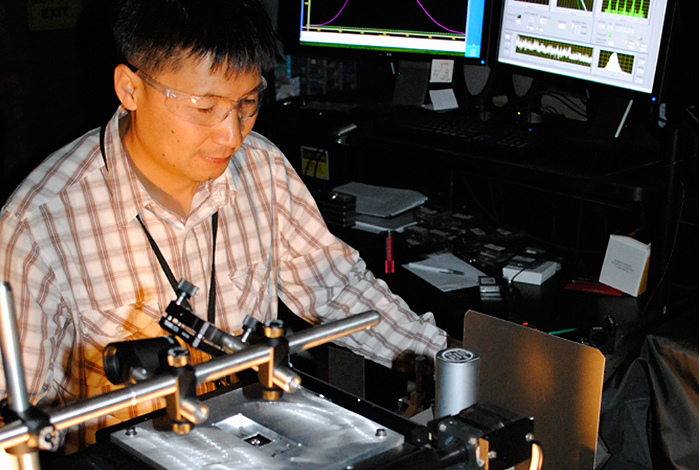Dramatic advances in the field of quantum dot light emitting diodes (QD-LEDs) could come from recent work by the Nanotechnology and Advanced Spectroscopy team at Los Alamos National Laboratory.
 |
|
Postdoctoral researcher Young-Shin Park characterizing emission spectra of LEDs in the Los Alamos National Laboratory optical laboratory. (source: Los Alamos National Laboratory) |
Quantum dots are nano-sized semiconductor particles whose emission color can be tuned by simply changing their dimensions. They feature near-unity emission quantum yields and narrow emission bands, which result in excellent color purity. The new research aims to improve QD-LEDs by using a new generation of engineered quantum dots tailored specifically to have reduced wasteful charge-carrier interactions that compete with the production of light.
“QD-LEDs can potentially provide many advantages over standard lighting technologies, such as incandescent bulbs, especially in the areas of efficiency, operating lifetime and the color quality of the emitted light,” said Victor Klimov of Los Alamos.
Incandescent bulbs, known for converting only 10 percent of electrical energy into light and losing 90 percent of it to heat, are rapidly being replaced worldwide by less wasteful fluorescent light sources. However, the most efficient approach to lighting is direct conversion of electricity into light using electroluminescent devices such as LEDs.
 |
|
The quantum dot device structure shown with a transmission electron microscopy (TEM) image of a cross-section of a real device.(source: Los Alamos National Laboratory) |
Due to spectrally narrow, tunable emission, and ease of processing, colloidal QDs are attractive materials for LED technologies. In the last decade, vigorous research in QD-LEDs has led to dramatic improvements in their performance, to the point where it nearly meets the requirements for commercial products. One outstanding challenge in the field is the so-called efficiency roll-off (known also as “droop”), that is, the drop in efficiency at high currents.
“This ‘droop’ problem complicates achieving practical levels of brightness required especially for lighting applications,” said Wan Ki Bae, a postdoctoral researcher on the nanotech team.
By conducting spectroscopic studies on operational QD-LEDs, the Los Alamos researchers have established that the main factor responsible for the reduction in efficiency is an effect called Auger recombination. In this process, instead of being emitted as a photon, the energy from recombination of an excited electron and hole is transferred to the excess charge and subsequently dissipated as heat.
A paper, “Controlling the influence of Auger recombination on the performance of quantum-dot light-emitting diodes” is being published Oct. 25 in Nature Communications. In addition, an overview article on the field of quantum-dot light-emitting diodes and specifically the role of Auger effects appeared in the September Materials Research Society Bulletin, Volume 38, Issue 09, also authored by researchers of the Los Alamos nanotech team.
Not only has this work identified the mechanism for efficiency losses in QD-LEDs, Klimov said, but it has also demonstrated two different nano-engineering strategies for circumventing the problem in QD-LEDs based on bright quantum dots made of cadmium selenide cores overcoated with cadmium sulfide shells.
The first approach is to reduce the efficiency of Auger recombination itself, which can be done by incorporating a thin layer of cadmium selenide sulfide alloy at the core/shell interface of each quantum dot.
The other approach attacks the problem of charge imbalance by better controlling the flow of extra electrons into the dots themselves. This can be accomplished by coating each dot in a thin layer of zinc cadmium sulfide, which selectively impedes electron injection. According to Jeffrey Pietryga, a chemist in the nanotech team, “This fine tuning of electron and hole injection currents helps maintain the dots in a charge-neutral state and thus prevents activation of Auger recombination.”
These studies were funded by a grant from the U.S. Department of Energy Office of Science.





 CN
TW
EN
CN
TW
EN







